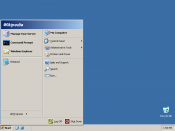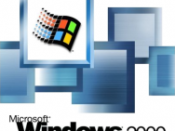Hardware Requirements
Both Windows 2000 and Linux run on most of the servers on the market today. Linux has an advantage of running on older server networking hardware, where as Windows 2000 will tend to lag on older machines. Even though lag time may be a deciding factor, both network operating systems will be compatible. Linux has the upper hand with proprietary servers from Sun and HP, but Sun has made a deal with Microsoft to work compatibility of Windows server 2000 into its hardware. Below are minimum and maximum hardware requirements.
Windows Server 2000 Standard Edition
Component Requirement
Computer and processor PC with a 133-MHz processor required; 550-MHz or faster processor recommended (Windows Server 2003 Standard Edition supports up to four processors on one server)
Memory 128 MB of RAM required; 256 MB or more recommended; 4 GB maximum
Hard disk 1.25 to 2 GB of available hard-disk space
Drive CD-ROM or DVD-ROM drive
Display VGA or hardware that supports console redirection required; Super VGA supporting 800 x 600 or higher-resolution monitor recommended
Microsoft Windows Server 2000 Enterprise Edition
Component Requirement
Computer and processor 133-MHz or faster processor for x86-based PCs; 733-MHz for Itanium-based PCs; up to eight processors supported on either the 32-bit or the 64-bit version
Memory 128 MB of RAM minimum required; maximum: 32 GB for x86-based PCs with the 32-bit version and 64 GB for Itanium-based PCs with the 64-bit version
Hard disk 1.5
GB of available hard-disk space for x86-based PCs; 2 GB for Itanium-based PCs; additional space is required if installing over a network
Drive CD-ROM or DVD-ROM drive
Display VGA or hardware that supports console redirection required
Other Windows Server 2003 Enterprise Edition, 64-bit version is compatible only with 64-bit Intel Itanium-based systems and cannot install on 32-bit systems
A network administrator...


